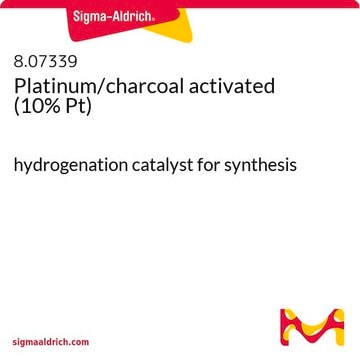If this product has an expiration or retest date, it will be shown on the Certificate of Analysis (COA, CofA). If there is no retest or expiration date listed on the product's COA, we do not have suitable stability data to determine a shelf life. For these products, the only date on the COA will be the release date; a retest, expiration, or use-by-date will not be displayed.
For all products, we recommend handling per defined conditions as printed in our product literature and website product descriptions. We recommend that products should be routinely inspected by customers to ensure they perform as expected.
For products without retest or expiration dates, our standard warranty of 1 year from the date of shipment is applicable.
For more information, please refer to the Product Dating Information document: https://www.sigmaaldrich.com/deepweb/assets/sigmaaldrich/marketing/global/documents/449/386/product-dating-information-mk.pdf
738549
Platinum on graphitized carbon
extent of labeling: 20 wt. % loading
Sinónimos:
20% Pt on Vulcan XC72, 20% Pt/Vulcan
About This Item
Productos recomendados
Formulario
powder
Nivel de calidad
idoneidad de la reacción
reagent type: catalyst
core: platinum
características de los productos alternativos más sostenibles
Design for Energy Efficiency
Learn more about the Principles of Green Chemistry.
sustainability
Greener Alternative Product
Extensión del etiquetado
20 wt. % loading
tamaño de partícula
<5 nm (Pt)
categoría alternativa más sostenible
, Enabling
cadena SMILES
[Pt]
InChI
1S/Pt
Clave InChI
BASFCYQUMIYNBI-UHFFFAOYSA-N
¿Está buscando productos similares? Visita Guía de comparación de productos
1 of 4
Este artículo | 738557 | 330159 | 738573 |
|---|---|---|---|
| form powder | form powder | form powder | form powder |
| Quality Level 100 | Quality Level 100 | Quality Level 100 | Quality Level 100 |
| greener alternative product characteristics Design for Energy Efficiency | greener alternative product characteristics Design for Energy Efficiency | greener alternative product characteristics - | greener alternative product characteristics Design for Energy Efficiency |
| sustainability Greener Alternative Product | sustainability Greener Alternative Product | sustainability - | sustainability Greener Alternative Product |
| extent of labeling 20 wt. % loading | extent of labeling 40 wt. % loading | extent of labeling 5 wt. % loading (dry basis) | extent of labeling 20 wt. % Pt loading, 10 wt. % Ru loading |
Aplicación
Otras notas
Palabra de señalización
Danger
Frases de peligro
Consejos de prudencia
Clasificaciones de peligro
Flam. Sol. 1
Código de clase de almacenamiento
4.1B - Flammable solid hazardous materials
Clase de riesgo para el agua (WGK)
nwg
Punto de inflamabilidad (°F)
Not applicable
Punto de inflamabilidad (°C)
Not applicable
Elija entre una de las versiones más recientes:
¿Ya tiene este producto?
Encuentre la documentación para los productos que ha comprado recientemente en la Biblioteca de documentos.
Los clientes también vieron
Artículos
Proton exchange membrane (PEM) fuel cells operate at relatively low temperatures and are composed of two electrodes and a conductive elecrolyte.
-
How can I determine the shelf life / expiration / retest date of this product?
1 answer-
Helpful?
-
-
How is shipping temperature determined? And how is it related to the product storage temperature?
1 answer-
Products may be shipped at a different temperature than the recommended long-term storage temperature. If the product quality is sensitive to short-term exposure to conditions other than the recommended long-term storage, it will be shipped on wet or dry-ice. If the product quality is NOT affected by short-term exposure to conditions other than the recommended long-term storage, it will be shipped at ambient temperature. As shipping routes are configured for minimum transit times, shipping at ambient temperature helps control shipping costs for our customers. For more information, please refer to the Storage and Transport Conditions document: https://www.sigmaaldrich.com/deepweb/assets/sigmaaldrich/marketing/global/documents/316/622/storage-transport-conditions-mk.pdf
Helpful?
-
Active Filters
Nuestro equipo de científicos tiene experiencia en todas las áreas de investigación: Ciencias de la vida, Ciencia de los materiales, Síntesis química, Cromatografía, Analítica y muchas otras.
Póngase en contacto con el Servicio técnico








